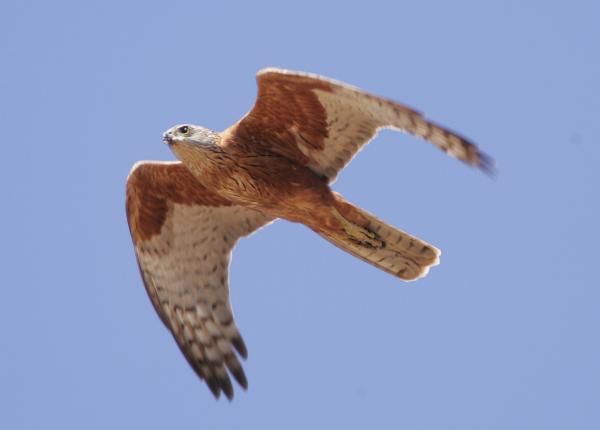Did You Know?
- The Red Goshawk has been described as "solitary and secretive."
- It is one of the rarest raptors in Australia
- This species is also known as Radiated Goshawk, Red Buzzard, and Rufous-bellied Buzzard.
How The Peregrine Fund is Helping
Though The Peregrine Fund doesn't work directly with the Red Goshawk, our efforts in scientific research, habitat conservation, education, and community development help conserve raptors on a global scale. We also supply literature to researchers from our avian research library, which helps scientists around the world gather and share important information on raptor conservation. Additionally, our support of the Global Raptor Information Network gives raptor researchers tools to more efficiently conduct their own studies while contributing to a global program. It also provides citizen scientists a way to participate in raptor science and conservation.
Where They Live
The Red Goshawk is native to Australia. It inhabits coastal and subcoastal forests and woodlands in the tropics and subtropics. If you are in Australia, make sure to look to the skies! The Red Goshawk can often be seen soaring over woodlands and tree-lined waterways, across grasslands and shrublands.
What They Do
This hawk is a diurnal - meaning it is active during the day and rests at night. It is not migratory and mostly stays within its home range throughout the year.
Why They Need our Help
This lovely goshawk is categorized as Near Threatened and it is facing some risks throughout its range. Deforestation, illegal egg collecting, and human disturbance at the nests are all threats that this species faces.
What They Eat
The Red Goshawk specializes in feeding on medium-sized to large birds including parrots, pigeons, herons, waterfowl, kookaburras, cockatoos, kingfishers, and lorikeets. But, its list of prey items doesn't end there. It will more rarely feed on mammals such as flying foxes - which aren't foxes at all, but are actually bats - and young hares. It also hunts snakes and lizards, and large insects.
The Red Goshawk most often hunts early in the morning and late in the day. It employs a few different hunting techniques to catch its prey. It might sit and wait on a concealed perch, or make long gliding or flying transects through trees or just above the canopy to search for something good to eat. It may catch its quarry in flight after an aerial chase, or it might surprise an unsuspecting animal by stooping down on it from a great height.
Nests, Eggs, and Young
Red Goshawks build a platform nests made of sticks and twigs, which they construct in an exposed fork of an emergent tree. The birds line the nest with green leaves.
The female will lay one to two eggs, which must be incubated for about 40 days. After the nestlings hatch, they will develop quickly and their flight feathers will slowly grow in. By the time they are around 51-53 days old, they will be ready to fly from the nest for the first time. After their initial flight, the young birds will remain in their parents' territory for another few months as they learn to hunt and avoid danger.
Red Goshawk and the World Center for Birds of Prey
The World Center for Birds of Prey offers fun ways to learn about birds of prey. Interactive activities, tours, interesting videos and a children's room with activities from coloring sheets to quizzes to costumes are all available for our guests. We also have knowledgeable, on-site staff to answer any questions you may have. Though we don't have any goshawks on our Avian Ambassador team, and we are from from the Red Goshawk's range, the Northern Goshawk can be found in Idaho year-round. They nest in large trees within the Sawtooth National Forest located only a few hours away from The Peregrine Fund's World Center for Birds of Prey.
References:
Debus, S., G. M. Kirwan, and D. A. Christie (2020). Red Goshawk (Erythrotriorchis radiatus), version 1.0. In Birds of the World (J. del Hoyo, A. Elliott, J. Sargatal, D. A. Christie, and E. de Juana, Editors). Cornell Lab of Ornithology, Ithaca, NY, USA. https://doi.org/10.2173/bow.redgos1.01
Global Raptor Information Network. 2022. Species account: Red Goshawk Erythrotriorchis radiatus. Downloaded from http://www.globalraptors.org on 30 Mar. 2022









